Managing and Leading People
VerifiedAdded on 2023/06/11
|16
|5109
|73
AI Summary
This report analyses the role of line managers in managing and leading people in organizations. It covers topics such as recruitment and selection, employee and labour relations, compensation and benefits, employee training and development, and more.
Contribute Materials
Your contribution can guide someone’s learning journey. Share your
documents today.
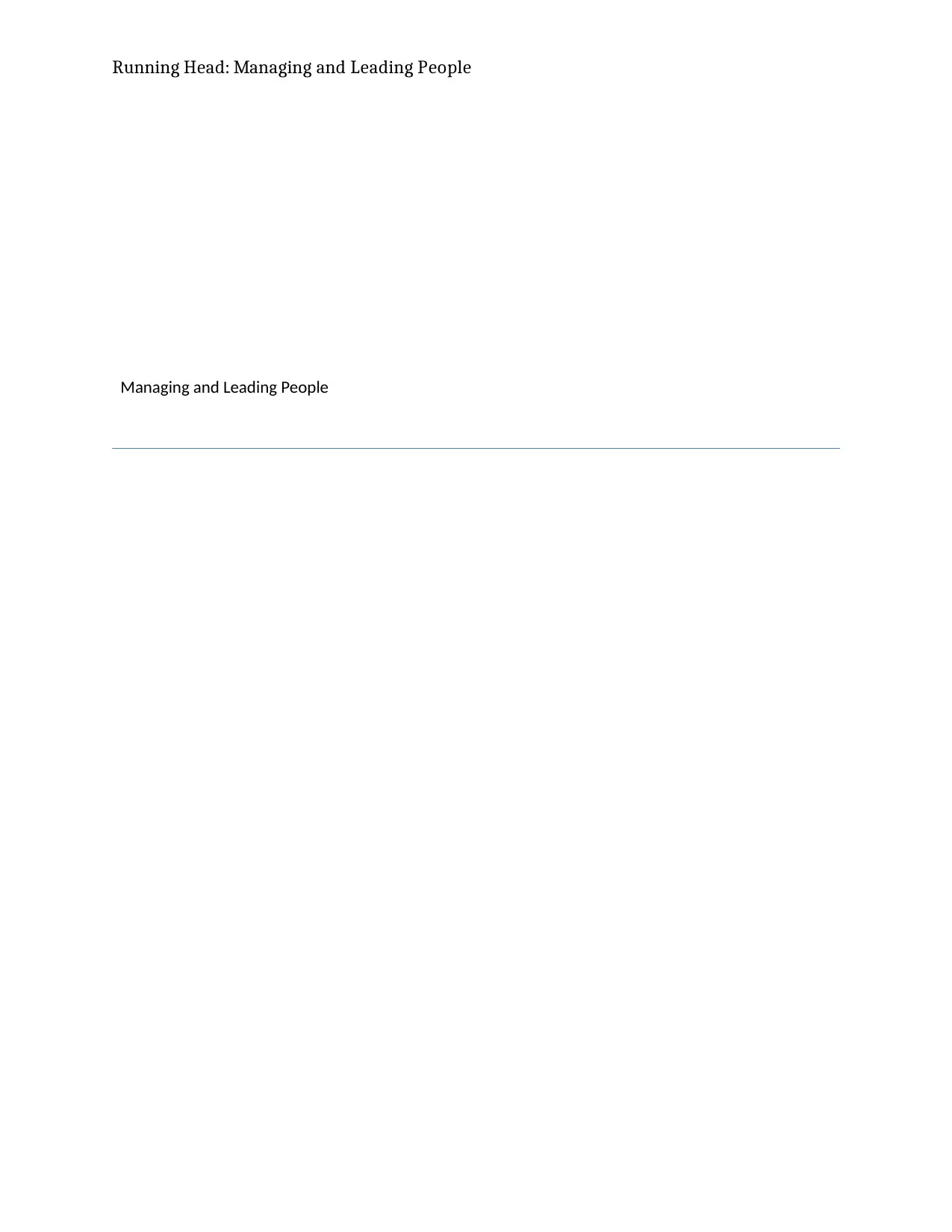
Running Head: Managing and Leading People
Managing and Leading People
Managing and Leading People
Secure Best Marks with AI Grader
Need help grading? Try our AI Grader for instant feedback on your assignments.

Managing and Leading people 1 | P a g e
Table of Contents
Recruitment & Selection..................................................................................................................2
Responsibilities of line manager in terms of recruitment and selection process.........................4
Employee and labour relations.................................................................................................5
Compensation and benefits......................................................................................................6
Employee training and development........................................................................................6
Models related to Recruitment and Selection..................................................................................7
Importance of line manager.........................................................................................................7
Relationship between line manager and HR representative.......................................................10
Department staffing................................................................................................................10
Workforce strategy.................................................................................................................10
Performance management......................................................................................................10
Conflict resolution..................................................................................................................11
Recruiting and talent acquisition............................................................................................11
Employee health and safety....................................................................................................12
Conclusion.....................................................................................................................................12
References......................................................................................................................................14
Table of Contents
Recruitment & Selection..................................................................................................................2
Responsibilities of line manager in terms of recruitment and selection process.........................4
Employee and labour relations.................................................................................................5
Compensation and benefits......................................................................................................6
Employee training and development........................................................................................6
Models related to Recruitment and Selection..................................................................................7
Importance of line manager.........................................................................................................7
Relationship between line manager and HR representative.......................................................10
Department staffing................................................................................................................10
Workforce strategy.................................................................................................................10
Performance management......................................................................................................10
Conflict resolution..................................................................................................................11
Recruiting and talent acquisition............................................................................................11
Employee health and safety....................................................................................................12
Conclusion.....................................................................................................................................12
References......................................................................................................................................14
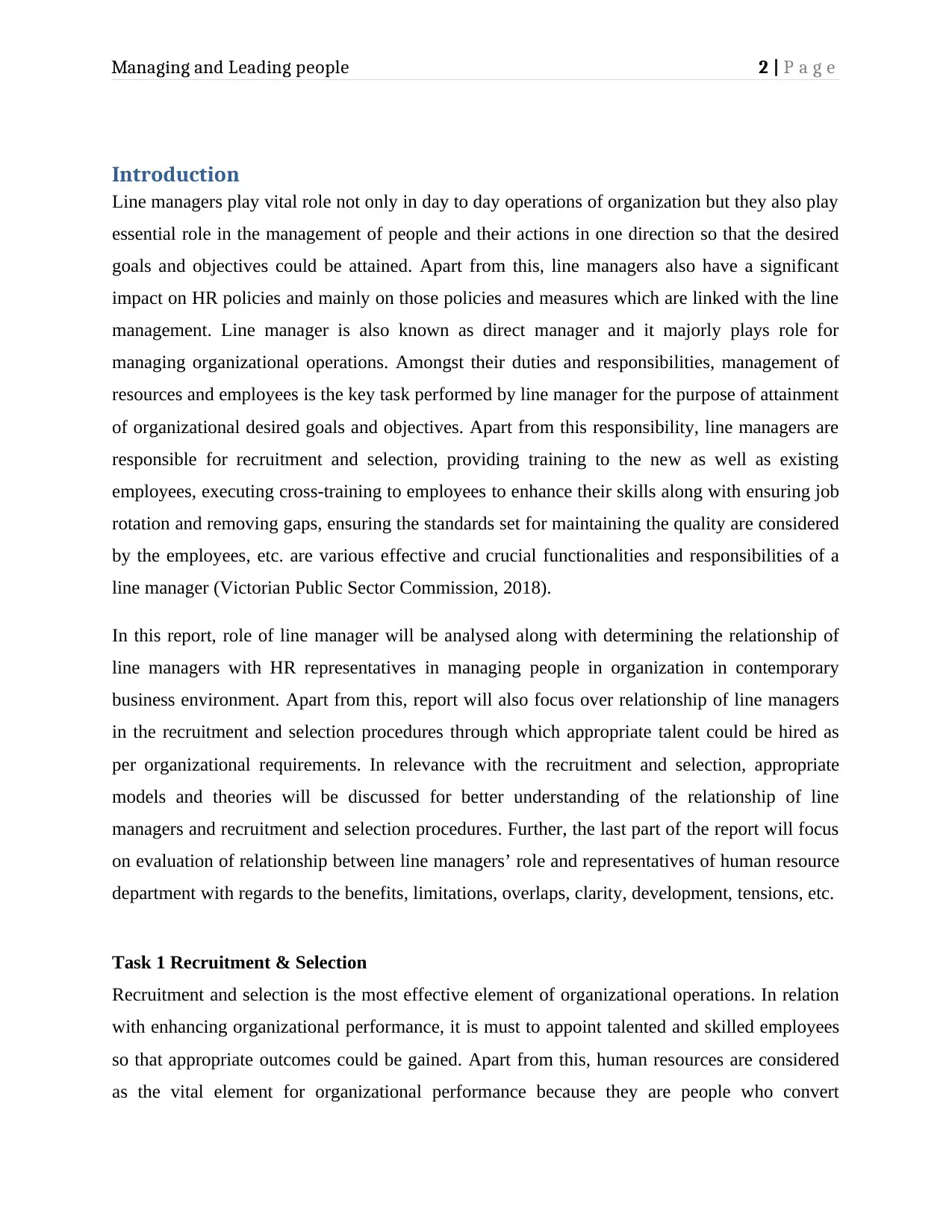
Managing and Leading people 2 | P a g e
Introduction
Line managers play vital role not only in day to day operations of organization but they also play
essential role in the management of people and their actions in one direction so that the desired
goals and objectives could be attained. Apart from this, line managers also have a significant
impact on HR policies and mainly on those policies and measures which are linked with the line
management. Line manager is also known as direct manager and it majorly plays role for
managing organizational operations. Amongst their duties and responsibilities, management of
resources and employees is the key task performed by line manager for the purpose of attainment
of organizational desired goals and objectives. Apart from this responsibility, line managers are
responsible for recruitment and selection, providing training to the new as well as existing
employees, executing cross-training to employees to enhance their skills along with ensuring job
rotation and removing gaps, ensuring the standards set for maintaining the quality are considered
by the employees, etc. are various effective and crucial functionalities and responsibilities of a
line manager (Victorian Public Sector Commission, 2018).
In this report, role of line manager will be analysed along with determining the relationship of
line managers with HR representatives in managing people in organization in contemporary
business environment. Apart from this, report will also focus over relationship of line managers
in the recruitment and selection procedures through which appropriate talent could be hired as
per organizational requirements. In relevance with the recruitment and selection, appropriate
models and theories will be discussed for better understanding of the relationship of line
managers and recruitment and selection procedures. Further, the last part of the report will focus
on evaluation of relationship between line managers’ role and representatives of human resource
department with regards to the benefits, limitations, overlaps, clarity, development, tensions, etc.
Task 1 Recruitment & Selection
Recruitment and selection is the most effective element of organizational operations. In relation
with enhancing organizational performance, it is must to appoint talented and skilled employees
so that appropriate outcomes could be gained. Apart from this, human resources are considered
as the vital element for organizational performance because they are people who convert
Introduction
Line managers play vital role not only in day to day operations of organization but they also play
essential role in the management of people and their actions in one direction so that the desired
goals and objectives could be attained. Apart from this, line managers also have a significant
impact on HR policies and mainly on those policies and measures which are linked with the line
management. Line manager is also known as direct manager and it majorly plays role for
managing organizational operations. Amongst their duties and responsibilities, management of
resources and employees is the key task performed by line manager for the purpose of attainment
of organizational desired goals and objectives. Apart from this responsibility, line managers are
responsible for recruitment and selection, providing training to the new as well as existing
employees, executing cross-training to employees to enhance their skills along with ensuring job
rotation and removing gaps, ensuring the standards set for maintaining the quality are considered
by the employees, etc. are various effective and crucial functionalities and responsibilities of a
line manager (Victorian Public Sector Commission, 2018).
In this report, role of line manager will be analysed along with determining the relationship of
line managers with HR representatives in managing people in organization in contemporary
business environment. Apart from this, report will also focus over relationship of line managers
in the recruitment and selection procedures through which appropriate talent could be hired as
per organizational requirements. In relevance with the recruitment and selection, appropriate
models and theories will be discussed for better understanding of the relationship of line
managers and recruitment and selection procedures. Further, the last part of the report will focus
on evaluation of relationship between line managers’ role and representatives of human resource
department with regards to the benefits, limitations, overlaps, clarity, development, tensions, etc.
Task 1 Recruitment & Selection
Recruitment and selection is the most effective element of organizational operations. In relation
with enhancing organizational performance, it is must to appoint talented and skilled employees
so that appropriate outcomes could be gained. Apart from this, human resources are considered
as the vital element for organizational performance because they are people who convert
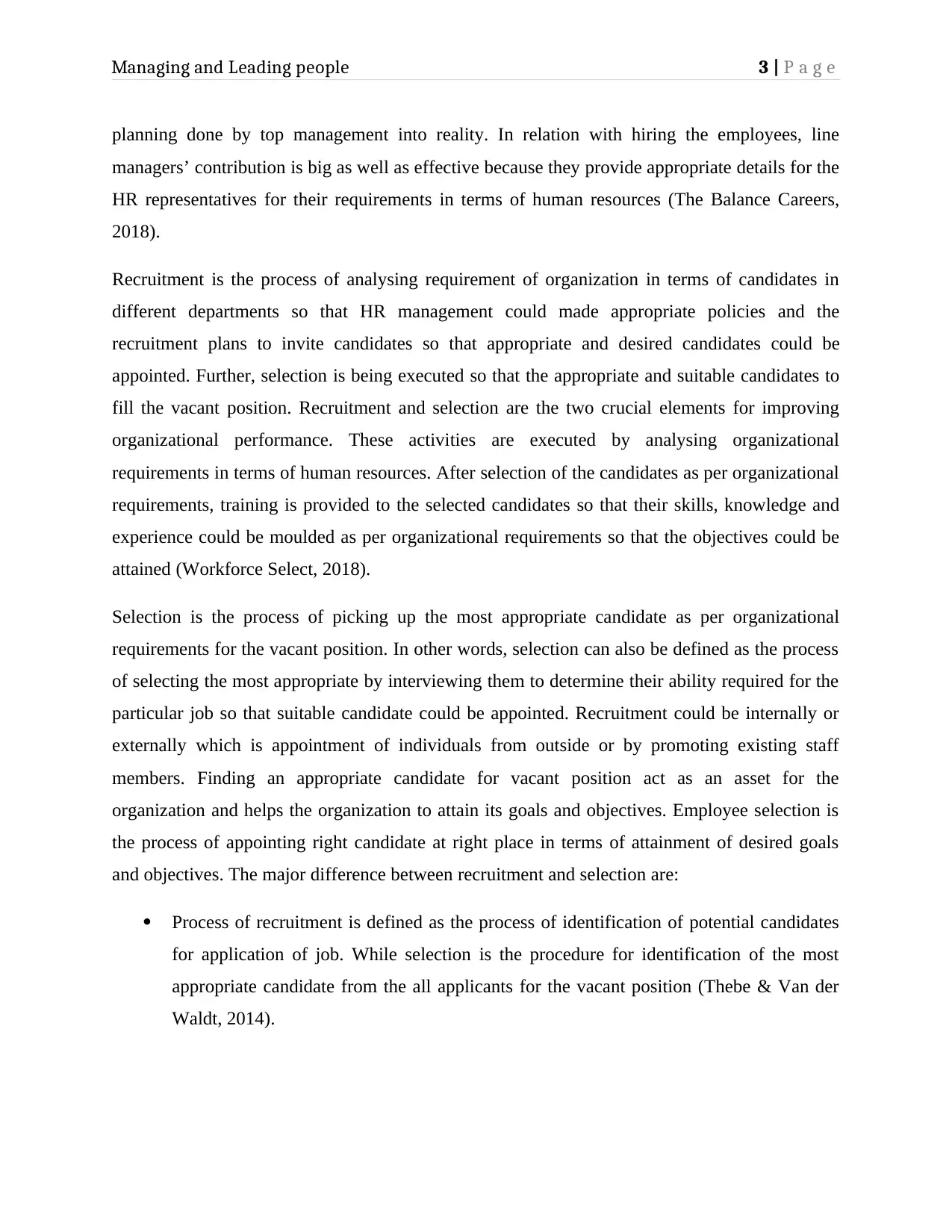
Managing and Leading people 3 | P a g e
planning done by top management into reality. In relation with hiring the employees, line
managers’ contribution is big as well as effective because they provide appropriate details for the
HR representatives for their requirements in terms of human resources (The Balance Careers,
2018).
Recruitment is the process of analysing requirement of organization in terms of candidates in
different departments so that HR management could made appropriate policies and the
recruitment plans to invite candidates so that appropriate and desired candidates could be
appointed. Further, selection is being executed so that the appropriate and suitable candidates to
fill the vacant position. Recruitment and selection are the two crucial elements for improving
organizational performance. These activities are executed by analysing organizational
requirements in terms of human resources. After selection of the candidates as per organizational
requirements, training is provided to the selected candidates so that their skills, knowledge and
experience could be moulded as per organizational requirements so that the objectives could be
attained (Workforce Select, 2018).
Selection is the process of picking up the most appropriate candidate as per organizational
requirements for the vacant position. In other words, selection can also be defined as the process
of selecting the most appropriate by interviewing them to determine their ability required for the
particular job so that suitable candidate could be appointed. Recruitment could be internally or
externally which is appointment of individuals from outside or by promoting existing staff
members. Finding an appropriate candidate for vacant position act as an asset for the
organization and helps the organization to attain its goals and objectives. Employee selection is
the process of appointing right candidate at right place in terms of attainment of desired goals
and objectives. The major difference between recruitment and selection are:
Process of recruitment is defined as the process of identification of potential candidates
for application of job. While selection is the procedure for identification of the most
appropriate candidate from the all applicants for the vacant position (Thebe & Van der
Waldt, 2014).
planning done by top management into reality. In relation with hiring the employees, line
managers’ contribution is big as well as effective because they provide appropriate details for the
HR representatives for their requirements in terms of human resources (The Balance Careers,
2018).
Recruitment is the process of analysing requirement of organization in terms of candidates in
different departments so that HR management could made appropriate policies and the
recruitment plans to invite candidates so that appropriate and desired candidates could be
appointed. Further, selection is being executed so that the appropriate and suitable candidates to
fill the vacant position. Recruitment and selection are the two crucial elements for improving
organizational performance. These activities are executed by analysing organizational
requirements in terms of human resources. After selection of the candidates as per organizational
requirements, training is provided to the selected candidates so that their skills, knowledge and
experience could be moulded as per organizational requirements so that the objectives could be
attained (Workforce Select, 2018).
Selection is the process of picking up the most appropriate candidate as per organizational
requirements for the vacant position. In other words, selection can also be defined as the process
of selecting the most appropriate by interviewing them to determine their ability required for the
particular job so that suitable candidate could be appointed. Recruitment could be internally or
externally which is appointment of individuals from outside or by promoting existing staff
members. Finding an appropriate candidate for vacant position act as an asset for the
organization and helps the organization to attain its goals and objectives. Employee selection is
the process of appointing right candidate at right place in terms of attainment of desired goals
and objectives. The major difference between recruitment and selection are:
Process of recruitment is defined as the process of identification of potential candidates
for application of job. While selection is the procedure for identification of the most
appropriate candidate from the all applicants for the vacant position (Thebe & Van der
Waldt, 2014).
Secure Best Marks with AI Grader
Need help grading? Try our AI Grader for instant feedback on your assignments.
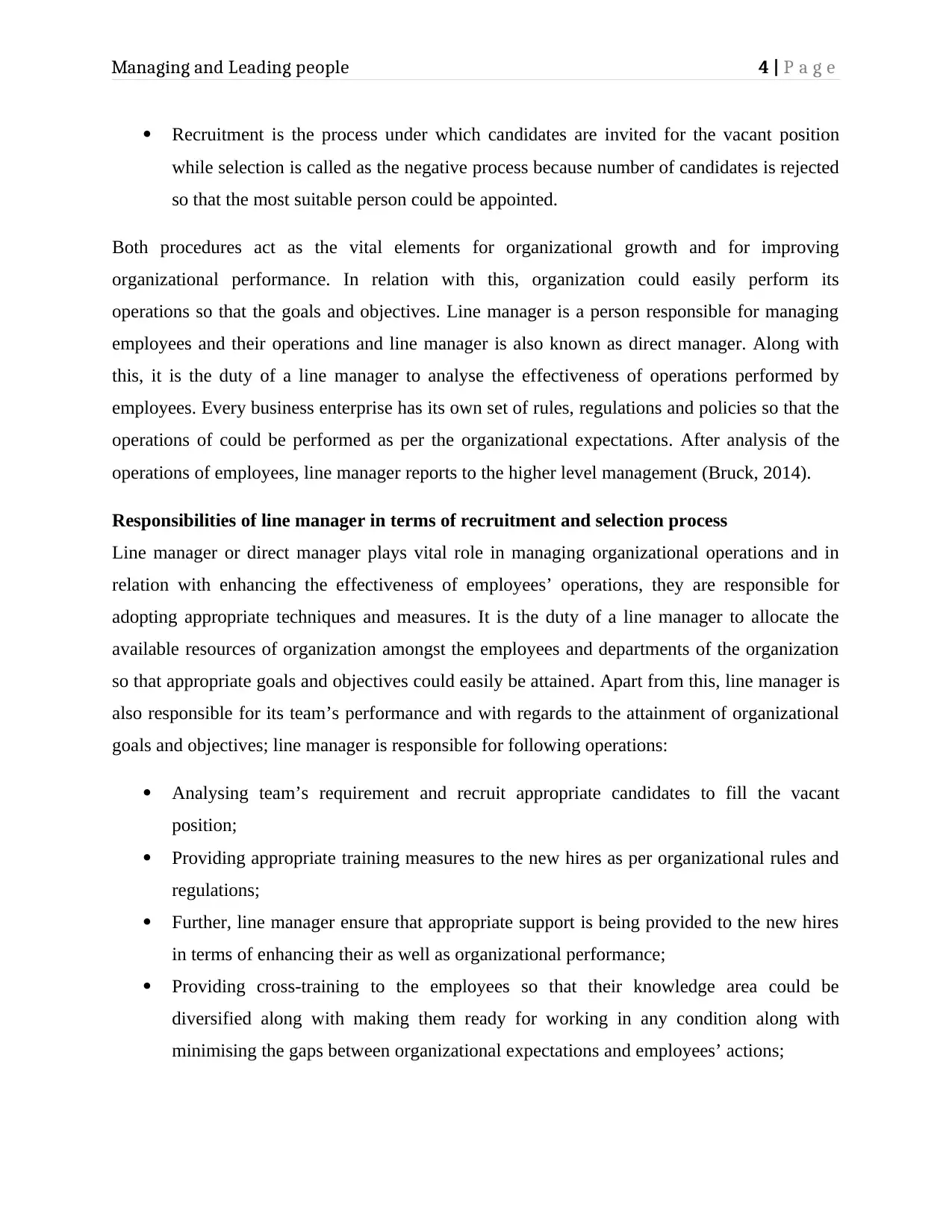
Managing and Leading people 4 | P a g e
Recruitment is the process under which candidates are invited for the vacant position
while selection is called as the negative process because number of candidates is rejected
so that the most suitable person could be appointed.
Both procedures act as the vital elements for organizational growth and for improving
organizational performance. In relation with this, organization could easily perform its
operations so that the goals and objectives. Line manager is a person responsible for managing
employees and their operations and line manager is also known as direct manager. Along with
this, it is the duty of a line manager to analyse the effectiveness of operations performed by
employees. Every business enterprise has its own set of rules, regulations and policies so that the
operations of could be performed as per the organizational expectations. After analysis of the
operations of employees, line manager reports to the higher level management (Bruck, 2014).
Responsibilities of line manager in terms of recruitment and selection process
Line manager or direct manager plays vital role in managing organizational operations and in
relation with enhancing the effectiveness of employees’ operations, they are responsible for
adopting appropriate techniques and measures. It is the duty of a line manager to allocate the
available resources of organization amongst the employees and departments of the organization
so that appropriate goals and objectives could easily be attained. Apart from this, line manager is
also responsible for its team’s performance and with regards to the attainment of organizational
goals and objectives; line manager is responsible for following operations:
Analysing team’s requirement and recruit appropriate candidates to fill the vacant
position;
Providing appropriate training measures to the new hires as per organizational rules and
regulations;
Further, line manager ensure that appropriate support is being provided to the new hires
in terms of enhancing their as well as organizational performance;
Providing cross-training to the employees so that their knowledge area could be
diversified along with making them ready for working in any condition along with
minimising the gaps between organizational expectations and employees’ actions;
Recruitment is the process under which candidates are invited for the vacant position
while selection is called as the negative process because number of candidates is rejected
so that the most suitable person could be appointed.
Both procedures act as the vital elements for organizational growth and for improving
organizational performance. In relation with this, organization could easily perform its
operations so that the goals and objectives. Line manager is a person responsible for managing
employees and their operations and line manager is also known as direct manager. Along with
this, it is the duty of a line manager to analyse the effectiveness of operations performed by
employees. Every business enterprise has its own set of rules, regulations and policies so that the
operations of could be performed as per the organizational expectations. After analysis of the
operations of employees, line manager reports to the higher level management (Bruck, 2014).
Responsibilities of line manager in terms of recruitment and selection process
Line manager or direct manager plays vital role in managing organizational operations and in
relation with enhancing the effectiveness of employees’ operations, they are responsible for
adopting appropriate techniques and measures. It is the duty of a line manager to allocate the
available resources of organization amongst the employees and departments of the organization
so that appropriate goals and objectives could easily be attained. Apart from this, line manager is
also responsible for its team’s performance and with regards to the attainment of organizational
goals and objectives; line manager is responsible for following operations:
Analysing team’s requirement and recruit appropriate candidates to fill the vacant
position;
Providing appropriate training measures to the new hires as per organizational rules and
regulations;
Further, line manager ensure that appropriate support is being provided to the new hires
in terms of enhancing their as well as organizational performance;
Providing cross-training to the employees so that their knowledge area could be
diversified along with making them ready for working in any condition along with
minimising the gaps between organizational expectations and employees’ actions;

Managing and Leading people 5 | P a g e
Providing regular feedbacks and coaching to the new hires on the basis of their actions.
This helps the employees to analyse effectiveness of their actions along with determining
the areas where improvement is required;
Communicating with employees and ensuring that they are moving towards attainment
of organizational goals, vision and mission;
Line manager is responsible for creating interactive workplace environment so that
employees could easily communicate with each other along with communicating to the
top level management without any barrier;
Further, lines managers compares employees’ performances with the expectations set up
by the management so that appropriate results could be gathered along with executing
appropriate monitoring and evaluation programs;
Next step taken by line manager is to identify the requirement for corrective actions for
enhancing organizational and employees’ efficiency;
Line manager ensures that the quality measures, rule, regulations and all other policies of
the organization are followed in all processes;
Evaluation of overall team performance and individual efforts in order to analyse the
effectiveness of the training sessions;
Engagement with the other line managers of organization so that measures could be
designed in an appropriate manner; and
Submitting reports to the top level management in relevance with productivity and other
performance indicators so that the acquired performance could be analysed.
Human resource department is not responsible for enhancing or generating revenues for the
organization, but they play vital role in doing so. Human resource management provides
appropriate training to the new hires as well as to the existing employees in consideration to the
departmental needs and wants. This helps the management to extract best from employees and
managers direct employees to walk upon the same path through which the desired goals and
objectives could be attained. HR department has various functions to do and one of those crucial
functions is recruitment and selection. In relation with this procedure, line manager complies
with HR manager so that the organizational requirements could be fulfilled in an appropriate
Providing regular feedbacks and coaching to the new hires on the basis of their actions.
This helps the employees to analyse effectiveness of their actions along with determining
the areas where improvement is required;
Communicating with employees and ensuring that they are moving towards attainment
of organizational goals, vision and mission;
Line manager is responsible for creating interactive workplace environment so that
employees could easily communicate with each other along with communicating to the
top level management without any barrier;
Further, lines managers compares employees’ performances with the expectations set up
by the management so that appropriate results could be gathered along with executing
appropriate monitoring and evaluation programs;
Next step taken by line manager is to identify the requirement for corrective actions for
enhancing organizational and employees’ efficiency;
Line manager ensures that the quality measures, rule, regulations and all other policies of
the organization are followed in all processes;
Evaluation of overall team performance and individual efforts in order to analyse the
effectiveness of the training sessions;
Engagement with the other line managers of organization so that measures could be
designed in an appropriate manner; and
Submitting reports to the top level management in relevance with productivity and other
performance indicators so that the acquired performance could be analysed.
Human resource department is not responsible for enhancing or generating revenues for the
organization, but they play vital role in doing so. Human resource management provides
appropriate training to the new hires as well as to the existing employees in consideration to the
departmental needs and wants. This helps the management to extract best from employees and
managers direct employees to walk upon the same path through which the desired goals and
objectives could be attained. HR department has various functions to do and one of those crucial
functions is recruitment and selection. In relation with this procedure, line manager complies
with HR manager so that the organizational requirements could be fulfilled in an appropriate
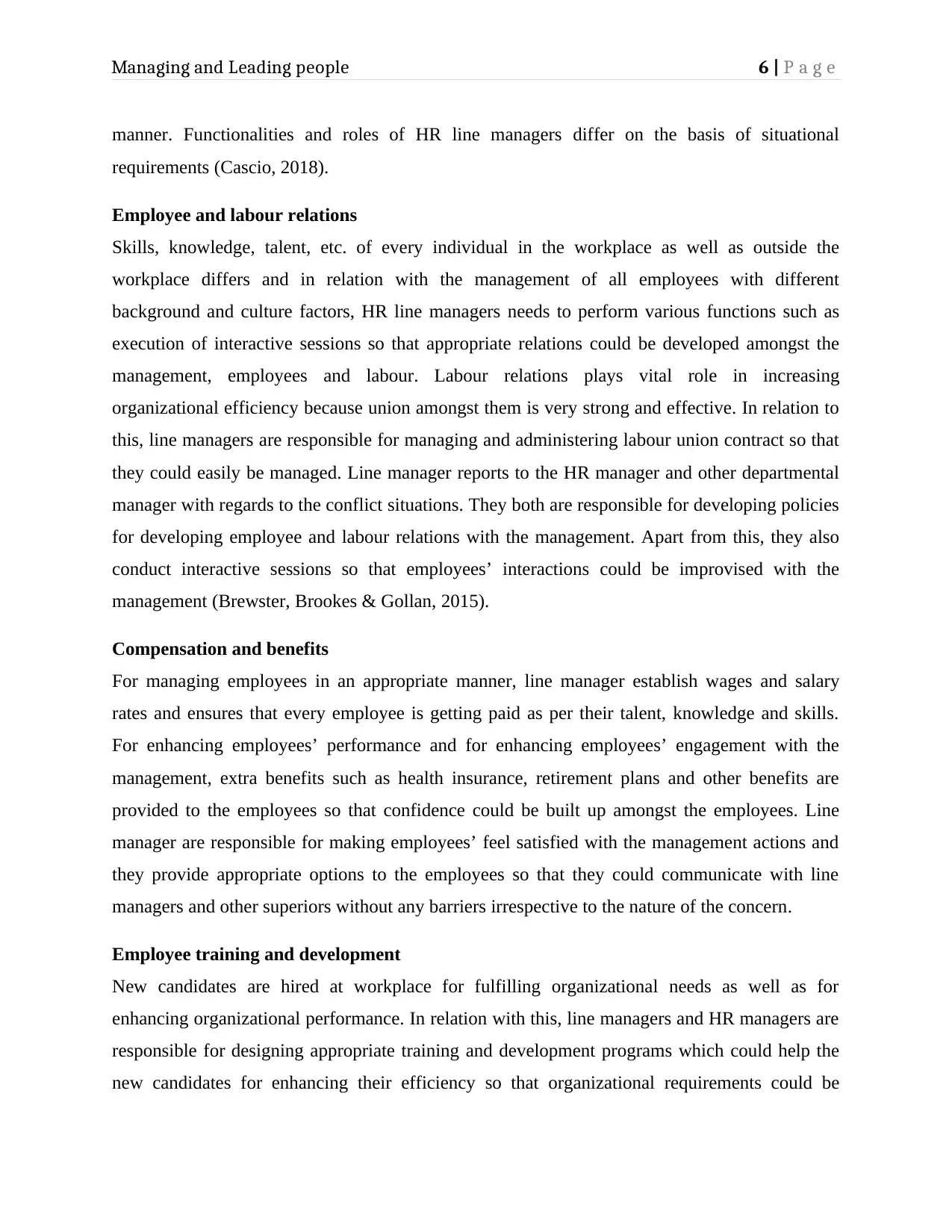
Managing and Leading people 6 | P a g e
manner. Functionalities and roles of HR line managers differ on the basis of situational
requirements (Cascio, 2018).
Employee and labour relations
Skills, knowledge, talent, etc. of every individual in the workplace as well as outside the
workplace differs and in relation with the management of all employees with different
background and culture factors, HR line managers needs to perform various functions such as
execution of interactive sessions so that appropriate relations could be developed amongst the
management, employees and labour. Labour relations plays vital role in increasing
organizational efficiency because union amongst them is very strong and effective. In relation to
this, line managers are responsible for managing and administering labour union contract so that
they could easily be managed. Line manager reports to the HR manager and other departmental
manager with regards to the conflict situations. They both are responsible for developing policies
for developing employee and labour relations with the management. Apart from this, they also
conduct interactive sessions so that employees’ interactions could be improvised with the
management (Brewster, Brookes & Gollan, 2015).
Compensation and benefits
For managing employees in an appropriate manner, line manager establish wages and salary
rates and ensures that every employee is getting paid as per their talent, knowledge and skills.
For enhancing employees’ performance and for enhancing employees’ engagement with the
management, extra benefits such as health insurance, retirement plans and other benefits are
provided to the employees so that confidence could be built up amongst the employees. Line
manager are responsible for making employees’ feel satisfied with the management actions and
they provide appropriate options to the employees so that they could communicate with line
managers and other superiors without any barriers irrespective to the nature of the concern.
Employee training and development
New candidates are hired at workplace for fulfilling organizational needs as well as for
enhancing organizational performance. In relation with this, line managers and HR managers are
responsible for designing appropriate training and development programs which could help the
new candidates for enhancing their efficiency so that organizational requirements could be
manner. Functionalities and roles of HR line managers differ on the basis of situational
requirements (Cascio, 2018).
Employee and labour relations
Skills, knowledge, talent, etc. of every individual in the workplace as well as outside the
workplace differs and in relation with the management of all employees with different
background and culture factors, HR line managers needs to perform various functions such as
execution of interactive sessions so that appropriate relations could be developed amongst the
management, employees and labour. Labour relations plays vital role in increasing
organizational efficiency because union amongst them is very strong and effective. In relation to
this, line managers are responsible for managing and administering labour union contract so that
they could easily be managed. Line manager reports to the HR manager and other departmental
manager with regards to the conflict situations. They both are responsible for developing policies
for developing employee and labour relations with the management. Apart from this, they also
conduct interactive sessions so that employees’ interactions could be improvised with the
management (Brewster, Brookes & Gollan, 2015).
Compensation and benefits
For managing employees in an appropriate manner, line manager establish wages and salary
rates and ensures that every employee is getting paid as per their talent, knowledge and skills.
For enhancing employees’ performance and for enhancing employees’ engagement with the
management, extra benefits such as health insurance, retirement plans and other benefits are
provided to the employees so that confidence could be built up amongst the employees. Line
manager are responsible for making employees’ feel satisfied with the management actions and
they provide appropriate options to the employees so that they could communicate with line
managers and other superiors without any barriers irrespective to the nature of the concern.
Employee training and development
New candidates are hired at workplace for fulfilling organizational needs as well as for
enhancing organizational performance. In relation with this, line managers and HR managers are
responsible for designing appropriate training and development programs which could help the
new candidates for enhancing their efficiency so that organizational requirements could be
Paraphrase This Document
Need a fresh take? Get an instant paraphrase of this document with our AI Paraphraser

Managing and Leading people 7 | P a g e
fulfilled. Apart from this, for converting new candidates’ skills, knowledge and talent as per
organizational requirements, desired goals and objectives could easily be attained (Crawshaw &
Game, 2015). Training and development programs are essential for enhancing an employee’s
efficiency. Designing of training and development sessions is necessary for the new employees
so that they could understand about the methods, procedures and pattern of organizational work.
Apart from this, with the help of training programs, managers could provide appropriate
information to the new candidates in relevance with the rules, regulations and policies of the
organization. Ramifications of non-following those rules and regulations are also discussed in
the training sessions so that appropriate goals and objectives could be attained. Main motive of
training and development programs is to direct organizational employees towards strategic
direction for overall workforce development so that organizational goals and objectives.
Task 2 Models related to Recruitment and Selection
Importance of line manager
It can easily be evaluated from the above discussed responsibilities that line managers play
crucial role in enhancing organizational efficiency. It is necessary for every manager and leader
to interact with its teammates for building confidence level amongst them. Apart from this, line
manager provides support to its employees and it act as the most appropriate element for
motivating employees. This helps the managers to extract best work from the employees along
with convincing them to work for attainment of organizational goals and objectives. This will
automatically help the employees to attain their goals along with determining various
opportunities for enhancing career growth. In relation with enhancing employees’ performance, a
good manager encourages its employees to think out of the box and also provides them
feedbacks on the basis of their performance on daily, monthly and annually basis. Line managers
are effective for enhancing organizational efficiency as they directly influence employee
satisfaction. Line managers are effective in employee engagement and these results in increasing
organizational productivity along with customer satisfaction.
Senior management is responsible for developing and framing strategies for the betterment of the
organization. Strategies are developed by the top level management in order to enhance
organizational requirements. These strategies, plans and procedures are developed and expected
fulfilled. Apart from this, for converting new candidates’ skills, knowledge and talent as per
organizational requirements, desired goals and objectives could easily be attained (Crawshaw &
Game, 2015). Training and development programs are essential for enhancing an employee’s
efficiency. Designing of training and development sessions is necessary for the new employees
so that they could understand about the methods, procedures and pattern of organizational work.
Apart from this, with the help of training programs, managers could provide appropriate
information to the new candidates in relevance with the rules, regulations and policies of the
organization. Ramifications of non-following those rules and regulations are also discussed in
the training sessions so that appropriate goals and objectives could be attained. Main motive of
training and development programs is to direct organizational employees towards strategic
direction for overall workforce development so that organizational goals and objectives.
Task 2 Models related to Recruitment and Selection
Importance of line manager
It can easily be evaluated from the above discussed responsibilities that line managers play
crucial role in enhancing organizational efficiency. It is necessary for every manager and leader
to interact with its teammates for building confidence level amongst them. Apart from this, line
manager provides support to its employees and it act as the most appropriate element for
motivating employees. This helps the managers to extract best work from the employees along
with convincing them to work for attainment of organizational goals and objectives. This will
automatically help the employees to attain their goals along with determining various
opportunities for enhancing career growth. In relation with enhancing employees’ performance, a
good manager encourages its employees to think out of the box and also provides them
feedbacks on the basis of their performance on daily, monthly and annually basis. Line managers
are effective for enhancing organizational efficiency as they directly influence employee
satisfaction. Line managers are effective in employee engagement and these results in increasing
organizational productivity along with customer satisfaction.
Senior management is responsible for developing and framing strategies for the betterment of the
organization. Strategies are developed by the top level management in order to enhance
organizational requirements. These strategies, plans and procedures are developed and expected
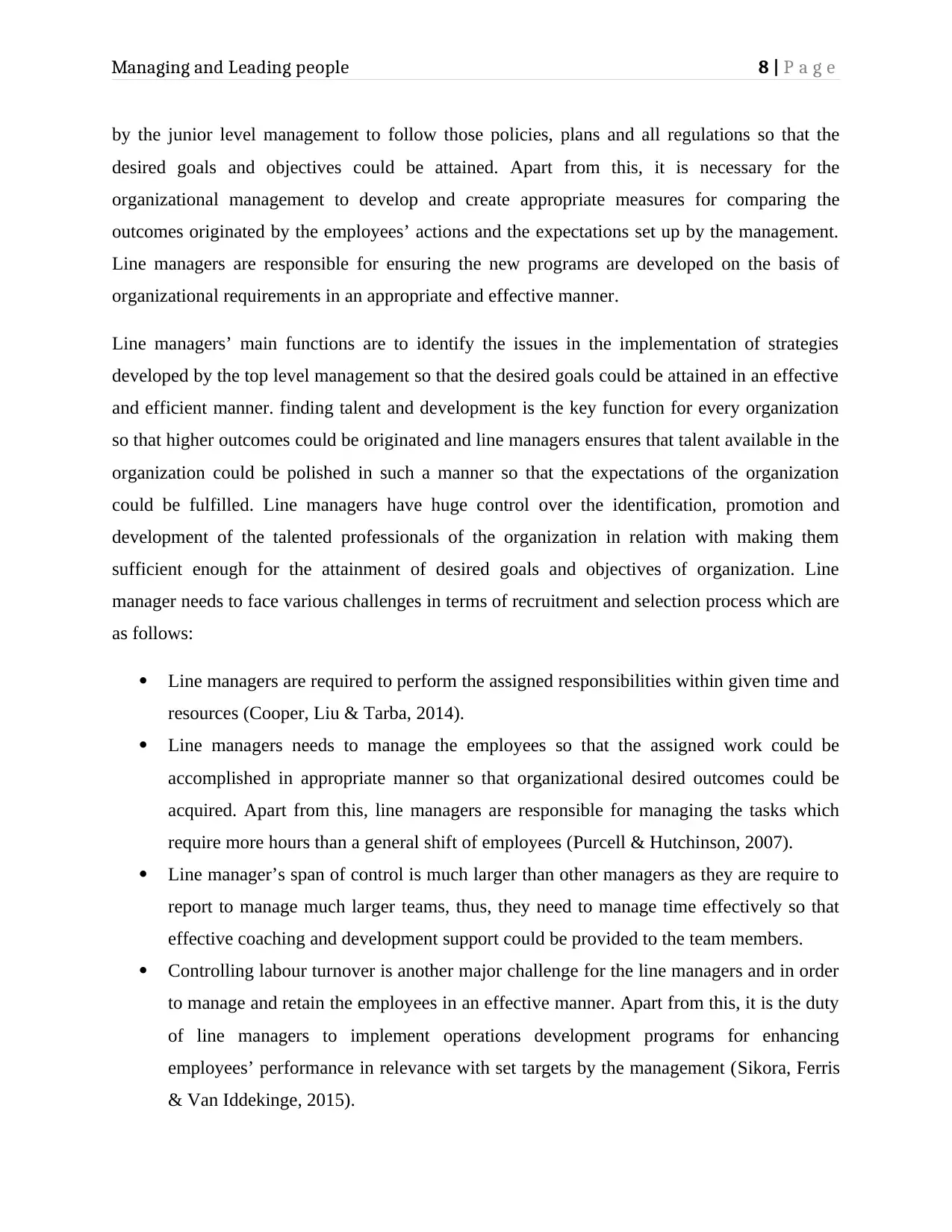
Managing and Leading people 8 | P a g e
by the junior level management to follow those policies, plans and all regulations so that the
desired goals and objectives could be attained. Apart from this, it is necessary for the
organizational management to develop and create appropriate measures for comparing the
outcomes originated by the employees’ actions and the expectations set up by the management.
Line managers are responsible for ensuring the new programs are developed on the basis of
organizational requirements in an appropriate and effective manner.
Line managers’ main functions are to identify the issues in the implementation of strategies
developed by the top level management so that the desired goals could be attained in an effective
and efficient manner. finding talent and development is the key function for every organization
so that higher outcomes could be originated and line managers ensures that talent available in the
organization could be polished in such a manner so that the expectations of the organization
could be fulfilled. Line managers have huge control over the identification, promotion and
development of the talented professionals of the organization in relation with making them
sufficient enough for the attainment of desired goals and objectives of organization. Line
manager needs to face various challenges in terms of recruitment and selection process which are
as follows:
Line managers are required to perform the assigned responsibilities within given time and
resources (Cooper, Liu & Tarba, 2014).
Line managers needs to manage the employees so that the assigned work could be
accomplished in appropriate manner so that organizational desired outcomes could be
acquired. Apart from this, line managers are responsible for managing the tasks which
require more hours than a general shift of employees (Purcell & Hutchinson, 2007).
Line manager’s span of control is much larger than other managers as they are require to
report to manage much larger teams, thus, they need to manage time effectively so that
effective coaching and development support could be provided to the team members.
Controlling labour turnover is another major challenge for the line managers and in order
to manage and retain the employees in an effective manner. Apart from this, it is the duty
of line managers to implement operations development programs for enhancing
employees’ performance in relevance with set targets by the management (Sikora, Ferris
& Van Iddekinge, 2015).
by the junior level management to follow those policies, plans and all regulations so that the
desired goals and objectives could be attained. Apart from this, it is necessary for the
organizational management to develop and create appropriate measures for comparing the
outcomes originated by the employees’ actions and the expectations set up by the management.
Line managers are responsible for ensuring the new programs are developed on the basis of
organizational requirements in an appropriate and effective manner.
Line managers’ main functions are to identify the issues in the implementation of strategies
developed by the top level management so that the desired goals could be attained in an effective
and efficient manner. finding talent and development is the key function for every organization
so that higher outcomes could be originated and line managers ensures that talent available in the
organization could be polished in such a manner so that the expectations of the organization
could be fulfilled. Line managers have huge control over the identification, promotion and
development of the talented professionals of the organization in relation with making them
sufficient enough for the attainment of desired goals and objectives of organization. Line
manager needs to face various challenges in terms of recruitment and selection process which are
as follows:
Line managers are required to perform the assigned responsibilities within given time and
resources (Cooper, Liu & Tarba, 2014).
Line managers needs to manage the employees so that the assigned work could be
accomplished in appropriate manner so that organizational desired outcomes could be
acquired. Apart from this, line managers are responsible for managing the tasks which
require more hours than a general shift of employees (Purcell & Hutchinson, 2007).
Line manager’s span of control is much larger than other managers as they are require to
report to manage much larger teams, thus, they need to manage time effectively so that
effective coaching and development support could be provided to the team members.
Controlling labour turnover is another major challenge for the line managers and in order
to manage and retain the employees in an effective manner. Apart from this, it is the duty
of line managers to implement operations development programs for enhancing
employees’ performance in relevance with set targets by the management (Sikora, Ferris
& Van Iddekinge, 2015).
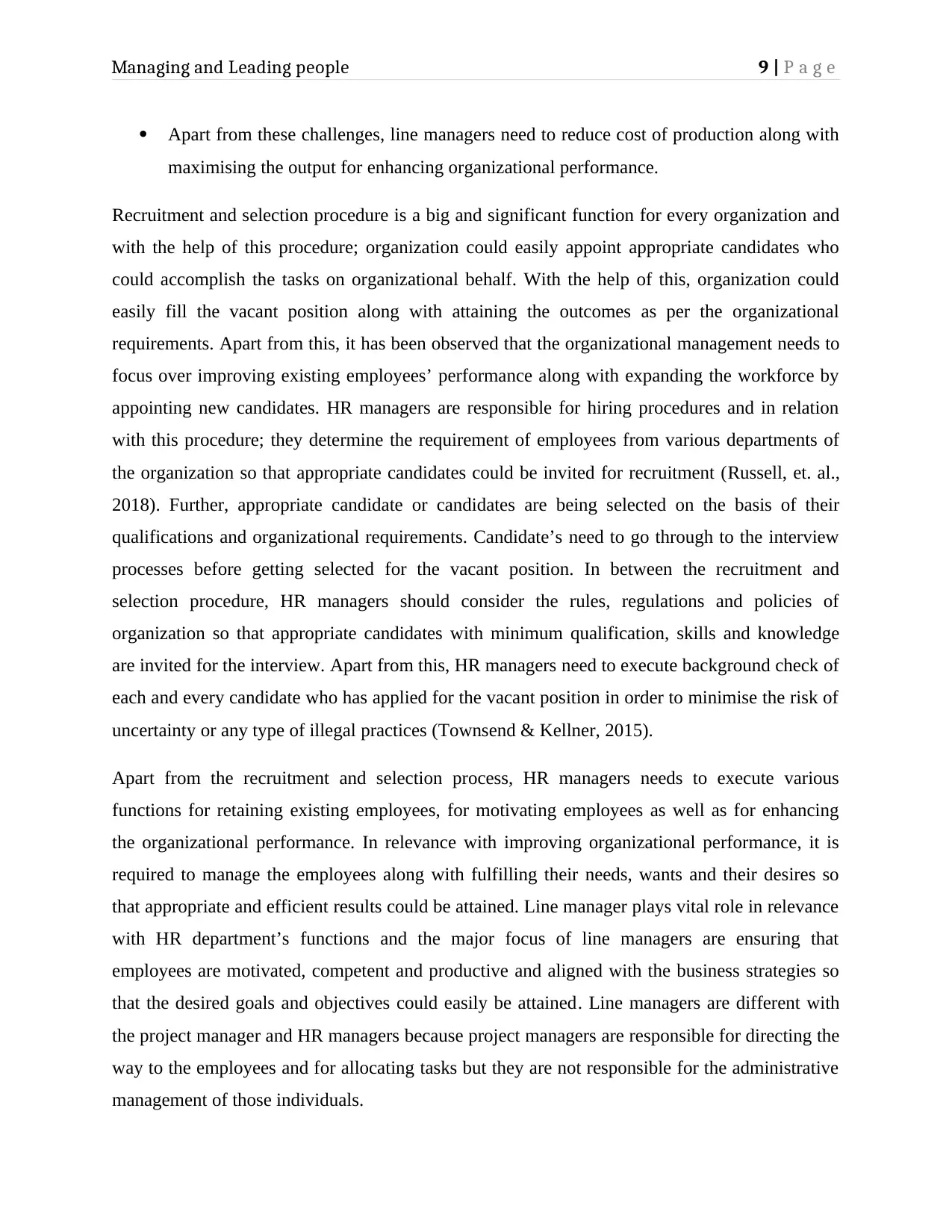
Managing and Leading people 9 | P a g e
Apart from these challenges, line managers need to reduce cost of production along with
maximising the output for enhancing organizational performance.
Recruitment and selection procedure is a big and significant function for every organization and
with the help of this procedure; organization could easily appoint appropriate candidates who
could accomplish the tasks on organizational behalf. With the help of this, organization could
easily fill the vacant position along with attaining the outcomes as per the organizational
requirements. Apart from this, it has been observed that the organizational management needs to
focus over improving existing employees’ performance along with expanding the workforce by
appointing new candidates. HR managers are responsible for hiring procedures and in relation
with this procedure; they determine the requirement of employees from various departments of
the organization so that appropriate candidates could be invited for recruitment (Russell, et. al.,
2018). Further, appropriate candidate or candidates are being selected on the basis of their
qualifications and organizational requirements. Candidate’s need to go through to the interview
processes before getting selected for the vacant position. In between the recruitment and
selection procedure, HR managers should consider the rules, regulations and policies of
organization so that appropriate candidates with minimum qualification, skills and knowledge
are invited for the interview. Apart from this, HR managers need to execute background check of
each and every candidate who has applied for the vacant position in order to minimise the risk of
uncertainty or any type of illegal practices (Townsend & Kellner, 2015).
Apart from the recruitment and selection process, HR managers needs to execute various
functions for retaining existing employees, for motivating employees as well as for enhancing
the organizational performance. In relevance with improving organizational performance, it is
required to manage the employees along with fulfilling their needs, wants and their desires so
that appropriate and efficient results could be attained. Line manager plays vital role in relevance
with HR department’s functions and the major focus of line managers are ensuring that
employees are motivated, competent and productive and aligned with the business strategies so
that the desired goals and objectives could easily be attained. Line managers are different with
the project manager and HR managers because project managers are responsible for directing the
way to the employees and for allocating tasks but they are not responsible for the administrative
management of those individuals.
Apart from these challenges, line managers need to reduce cost of production along with
maximising the output for enhancing organizational performance.
Recruitment and selection procedure is a big and significant function for every organization and
with the help of this procedure; organization could easily appoint appropriate candidates who
could accomplish the tasks on organizational behalf. With the help of this, organization could
easily fill the vacant position along with attaining the outcomes as per the organizational
requirements. Apart from this, it has been observed that the organizational management needs to
focus over improving existing employees’ performance along with expanding the workforce by
appointing new candidates. HR managers are responsible for hiring procedures and in relation
with this procedure; they determine the requirement of employees from various departments of
the organization so that appropriate candidates could be invited for recruitment (Russell, et. al.,
2018). Further, appropriate candidate or candidates are being selected on the basis of their
qualifications and organizational requirements. Candidate’s need to go through to the interview
processes before getting selected for the vacant position. In between the recruitment and
selection procedure, HR managers should consider the rules, regulations and policies of
organization so that appropriate candidates with minimum qualification, skills and knowledge
are invited for the interview. Apart from this, HR managers need to execute background check of
each and every candidate who has applied for the vacant position in order to minimise the risk of
uncertainty or any type of illegal practices (Townsend & Kellner, 2015).
Apart from the recruitment and selection process, HR managers needs to execute various
functions for retaining existing employees, for motivating employees as well as for enhancing
the organizational performance. In relevance with improving organizational performance, it is
required to manage the employees along with fulfilling their needs, wants and their desires so
that appropriate and efficient results could be attained. Line manager plays vital role in relevance
with HR department’s functions and the major focus of line managers are ensuring that
employees are motivated, competent and productive and aligned with the business strategies so
that the desired goals and objectives could easily be attained. Line managers are different with
the project manager and HR managers because project managers are responsible for directing the
way to the employees and for allocating tasks but they are not responsible for the administrative
management of those individuals.
Secure Best Marks with AI Grader
Need help grading? Try our AI Grader for instant feedback on your assignments.

Managing and Leading people 10 | P a g e
Task 3 Relationship between line manager and HR representative
Whereas line managers are responsible for providing coaching to the employees along with
setting targets and goals for them so that appropriate results could be attained. It is necessary for
both HR managers and line managers to work together because they both have vested their
interest in attainment of organizational goals and objectives. With the help of collaboration of
HR managers and line managers, line management become capable enough with regards to the
HR functions. This helps the line managers to devote their time towards development of
effective policies in relation with strategic HR department (Bratton & Gold, 2017).
Department staffing
Major function of HR department is to support workforce and fulfil their needs and
requirements. HR managers and line managers are required to communicate with each other so
that requirements could be determined department wise so that appropriate functions and
strategies could be adopted for the fulfilment of those requirements. Whenever, a vacant position
is analysed in the line management, both HR recruiters and line manager discuss the
requirements for the particular job for accuracy and completeness. HR managers suggest line
managers to determine the qualities of selected candidates on the basis of requirements and
organizational standards and policies (Brewster, 2017).
Workforce strategy
Strategic planning between line managers and HR managers involves reviewing projections for
concerning future business demands in relation with determining the requirement for the training
for employees. Apart from this, line managers also analyse the demand for the employees for the
purpose of fulfilment of organizational requirements. With the help of collaboration, line
managers and HR managers both could easily identify the immediate organizational needs.
Along with this, HR managers could also hire appropriate and desired candidates as per the
requirement of the vacant position. Cost could also be reduced along with increasing the returns.
Performance management
Performance management is an essential task for enhancing employees’ performance and in
relation with this, HR manager and line managers both contribute for making training and
development programs effective and efficient. Amongst them, one of the best techniques for
Task 3 Relationship between line manager and HR representative
Whereas line managers are responsible for providing coaching to the employees along with
setting targets and goals for them so that appropriate results could be attained. It is necessary for
both HR managers and line managers to work together because they both have vested their
interest in attainment of organizational goals and objectives. With the help of collaboration of
HR managers and line managers, line management become capable enough with regards to the
HR functions. This helps the line managers to devote their time towards development of
effective policies in relation with strategic HR department (Bratton & Gold, 2017).
Department staffing
Major function of HR department is to support workforce and fulfil their needs and
requirements. HR managers and line managers are required to communicate with each other so
that requirements could be determined department wise so that appropriate functions and
strategies could be adopted for the fulfilment of those requirements. Whenever, a vacant position
is analysed in the line management, both HR recruiters and line manager discuss the
requirements for the particular job for accuracy and completeness. HR managers suggest line
managers to determine the qualities of selected candidates on the basis of requirements and
organizational standards and policies (Brewster, 2017).
Workforce strategy
Strategic planning between line managers and HR managers involves reviewing projections for
concerning future business demands in relation with determining the requirement for the training
for employees. Apart from this, line managers also analyse the demand for the employees for the
purpose of fulfilment of organizational requirements. With the help of collaboration, line
managers and HR managers both could easily identify the immediate organizational needs.
Along with this, HR managers could also hire appropriate and desired candidates as per the
requirement of the vacant position. Cost could also be reduced along with increasing the returns.
Performance management
Performance management is an essential task for enhancing employees’ performance and in
relation with this, HR manager and line managers both contribute for making training and
development programs effective and efficient. Amongst them, one of the best techniques for
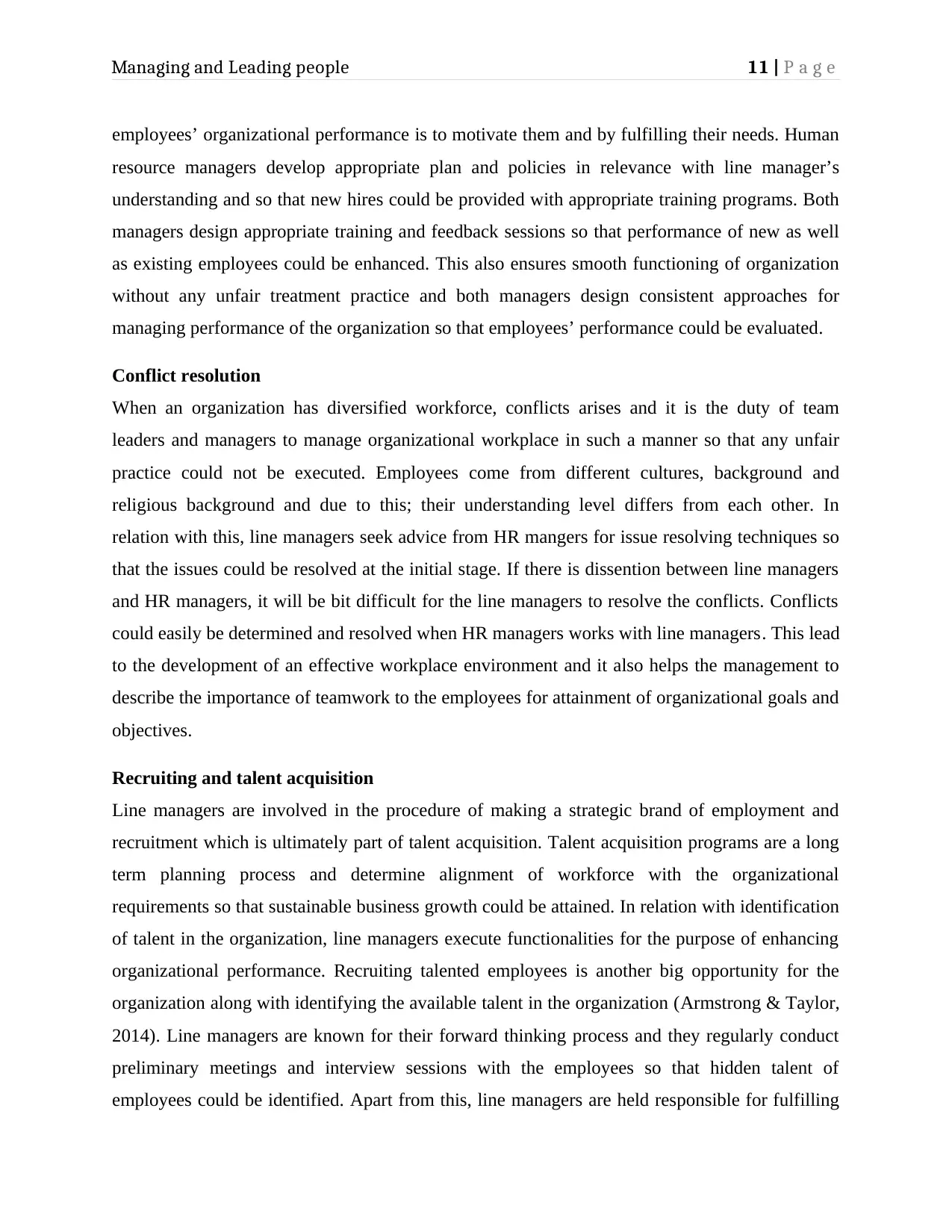
Managing and Leading people 11 | P a g e
employees’ organizational performance is to motivate them and by fulfilling their needs. Human
resource managers develop appropriate plan and policies in relevance with line manager’s
understanding and so that new hires could be provided with appropriate training programs. Both
managers design appropriate training and feedback sessions so that performance of new as well
as existing employees could be enhanced. This also ensures smooth functioning of organization
without any unfair treatment practice and both managers design consistent approaches for
managing performance of the organization so that employees’ performance could be evaluated.
Conflict resolution
When an organization has diversified workforce, conflicts arises and it is the duty of team
leaders and managers to manage organizational workplace in such a manner so that any unfair
practice could not be executed. Employees come from different cultures, background and
religious background and due to this; their understanding level differs from each other. In
relation with this, line managers seek advice from HR mangers for issue resolving techniques so
that the issues could be resolved at the initial stage. If there is dissention between line managers
and HR managers, it will be bit difficult for the line managers to resolve the conflicts. Conflicts
could easily be determined and resolved when HR managers works with line managers. This lead
to the development of an effective workplace environment and it also helps the management to
describe the importance of teamwork to the employees for attainment of organizational goals and
objectives.
Recruiting and talent acquisition
Line managers are involved in the procedure of making a strategic brand of employment and
recruitment which is ultimately part of talent acquisition. Talent acquisition programs are a long
term planning process and determine alignment of workforce with the organizational
requirements so that sustainable business growth could be attained. In relation with identification
of talent in the organization, line managers execute functionalities for the purpose of enhancing
organizational performance. Recruiting talented employees is another big opportunity for the
organization along with identifying the available talent in the organization (Armstrong & Taylor,
2014). Line managers are known for their forward thinking process and they regularly conduct
preliminary meetings and interview sessions with the employees so that hidden talent of
employees could be identified. Apart from this, line managers are held responsible for fulfilling
employees’ organizational performance is to motivate them and by fulfilling their needs. Human
resource managers develop appropriate plan and policies in relevance with line manager’s
understanding and so that new hires could be provided with appropriate training programs. Both
managers design appropriate training and feedback sessions so that performance of new as well
as existing employees could be enhanced. This also ensures smooth functioning of organization
without any unfair treatment practice and both managers design consistent approaches for
managing performance of the organization so that employees’ performance could be evaluated.
Conflict resolution
When an organization has diversified workforce, conflicts arises and it is the duty of team
leaders and managers to manage organizational workplace in such a manner so that any unfair
practice could not be executed. Employees come from different cultures, background and
religious background and due to this; their understanding level differs from each other. In
relation with this, line managers seek advice from HR mangers for issue resolving techniques so
that the issues could be resolved at the initial stage. If there is dissention between line managers
and HR managers, it will be bit difficult for the line managers to resolve the conflicts. Conflicts
could easily be determined and resolved when HR managers works with line managers. This lead
to the development of an effective workplace environment and it also helps the management to
describe the importance of teamwork to the employees for attainment of organizational goals and
objectives.
Recruiting and talent acquisition
Line managers are involved in the procedure of making a strategic brand of employment and
recruitment which is ultimately part of talent acquisition. Talent acquisition programs are a long
term planning process and determine alignment of workforce with the organizational
requirements so that sustainable business growth could be attained. In relation with identification
of talent in the organization, line managers execute functionalities for the purpose of enhancing
organizational performance. Recruiting talented employees is another big opportunity for the
organization along with identifying the available talent in the organization (Armstrong & Taylor,
2014). Line managers are known for their forward thinking process and they regularly conduct
preliminary meetings and interview sessions with the employees so that hidden talent of
employees could be identified. Apart from this, line managers are held responsible for fulfilling
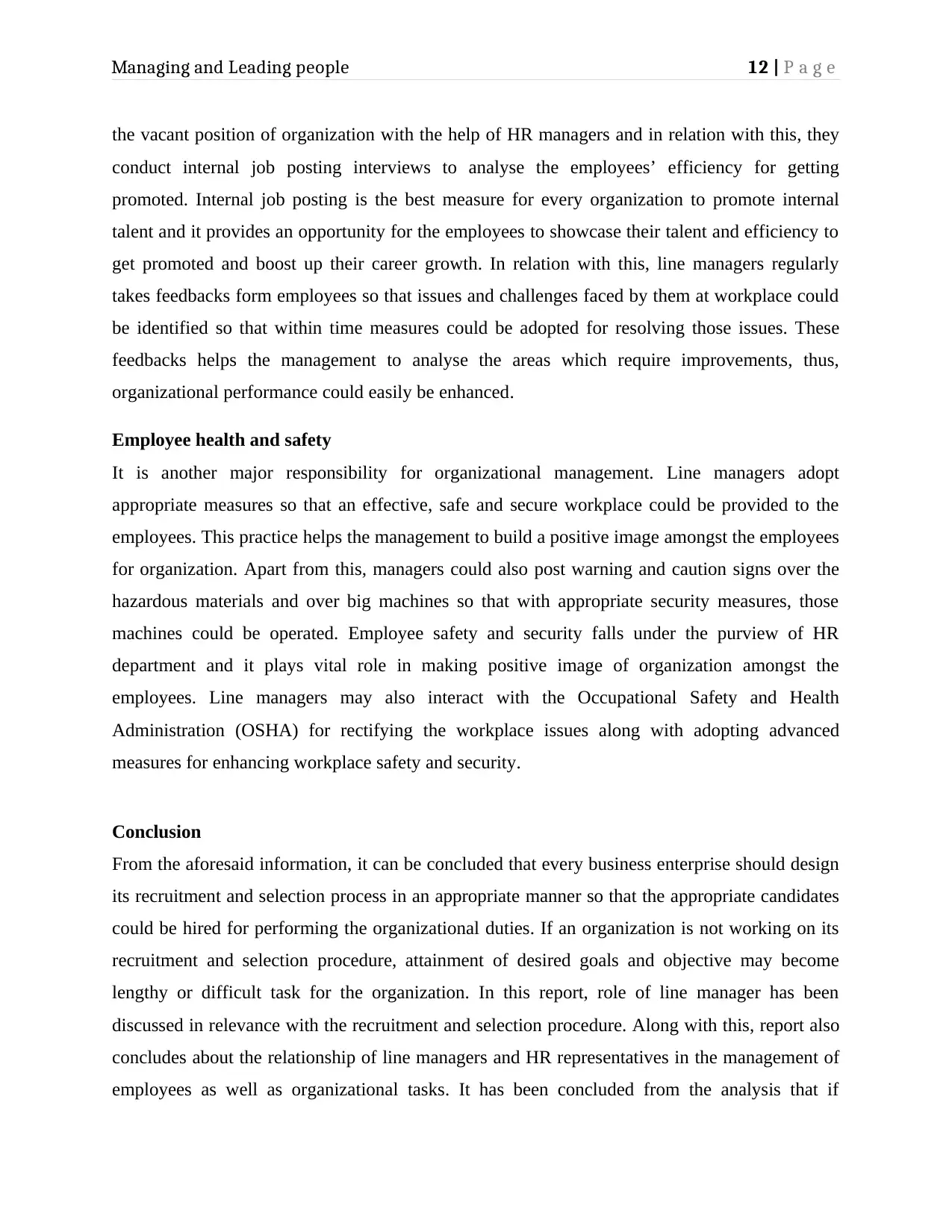
Managing and Leading people 12 | P a g e
the vacant position of organization with the help of HR managers and in relation with this, they
conduct internal job posting interviews to analyse the employees’ efficiency for getting
promoted. Internal job posting is the best measure for every organization to promote internal
talent and it provides an opportunity for the employees to showcase their talent and efficiency to
get promoted and boost up their career growth. In relation with this, line managers regularly
takes feedbacks form employees so that issues and challenges faced by them at workplace could
be identified so that within time measures could be adopted for resolving those issues. These
feedbacks helps the management to analyse the areas which require improvements, thus,
organizational performance could easily be enhanced.
Employee health and safety
It is another major responsibility for organizational management. Line managers adopt
appropriate measures so that an effective, safe and secure workplace could be provided to the
employees. This practice helps the management to build a positive image amongst the employees
for organization. Apart from this, managers could also post warning and caution signs over the
hazardous materials and over big machines so that with appropriate security measures, those
machines could be operated. Employee safety and security falls under the purview of HR
department and it plays vital role in making positive image of organization amongst the
employees. Line managers may also interact with the Occupational Safety and Health
Administration (OSHA) for rectifying the workplace issues along with adopting advanced
measures for enhancing workplace safety and security.
Conclusion
From the aforesaid information, it can be concluded that every business enterprise should design
its recruitment and selection process in an appropriate manner so that the appropriate candidates
could be hired for performing the organizational duties. If an organization is not working on its
recruitment and selection procedure, attainment of desired goals and objective may become
lengthy or difficult task for the organization. In this report, role of line manager has been
discussed in relevance with the recruitment and selection procedure. Along with this, report also
concludes about the relationship of line managers and HR representatives in the management of
employees as well as organizational tasks. It has been concluded from the analysis that if
the vacant position of organization with the help of HR managers and in relation with this, they
conduct internal job posting interviews to analyse the employees’ efficiency for getting
promoted. Internal job posting is the best measure for every organization to promote internal
talent and it provides an opportunity for the employees to showcase their talent and efficiency to
get promoted and boost up their career growth. In relation with this, line managers regularly
takes feedbacks form employees so that issues and challenges faced by them at workplace could
be identified so that within time measures could be adopted for resolving those issues. These
feedbacks helps the management to analyse the areas which require improvements, thus,
organizational performance could easily be enhanced.
Employee health and safety
It is another major responsibility for organizational management. Line managers adopt
appropriate measures so that an effective, safe and secure workplace could be provided to the
employees. This practice helps the management to build a positive image amongst the employees
for organization. Apart from this, managers could also post warning and caution signs over the
hazardous materials and over big machines so that with appropriate security measures, those
machines could be operated. Employee safety and security falls under the purview of HR
department and it plays vital role in making positive image of organization amongst the
employees. Line managers may also interact with the Occupational Safety and Health
Administration (OSHA) for rectifying the workplace issues along with adopting advanced
measures for enhancing workplace safety and security.
Conclusion
From the aforesaid information, it can be concluded that every business enterprise should design
its recruitment and selection process in an appropriate manner so that the appropriate candidates
could be hired for performing the organizational duties. If an organization is not working on its
recruitment and selection procedure, attainment of desired goals and objective may become
lengthy or difficult task for the organization. In this report, role of line manager has been
discussed in relevance with the recruitment and selection procedure. Along with this, report also
concludes about the relationship of line managers and HR representatives in the management of
employees as well as organizational tasks. It has been concluded from the analysis that if
Paraphrase This Document
Need a fresh take? Get an instant paraphrase of this document with our AI Paraphraser

Managing and Leading people 13 | P a g e
recruitment and selection program is being executed by line manager and HR manager,
appropriate and right candidates could easily be hired for filling the vacant position in the
organization along with enhancing organizational performance. Various other strategies,
techniques and procedures have also been discussed in relevance with finding the talent and
skilled candidates from within the organization or from outside the organization so that the
desired goals and objectives could easily be attained.
recruitment and selection program is being executed by line manager and HR manager,
appropriate and right candidates could easily be hired for filling the vacant position in the
organization along with enhancing organizational performance. Various other strategies,
techniques and procedures have also been discussed in relevance with finding the talent and
skilled candidates from within the organization or from outside the organization so that the
desired goals and objectives could easily be attained.
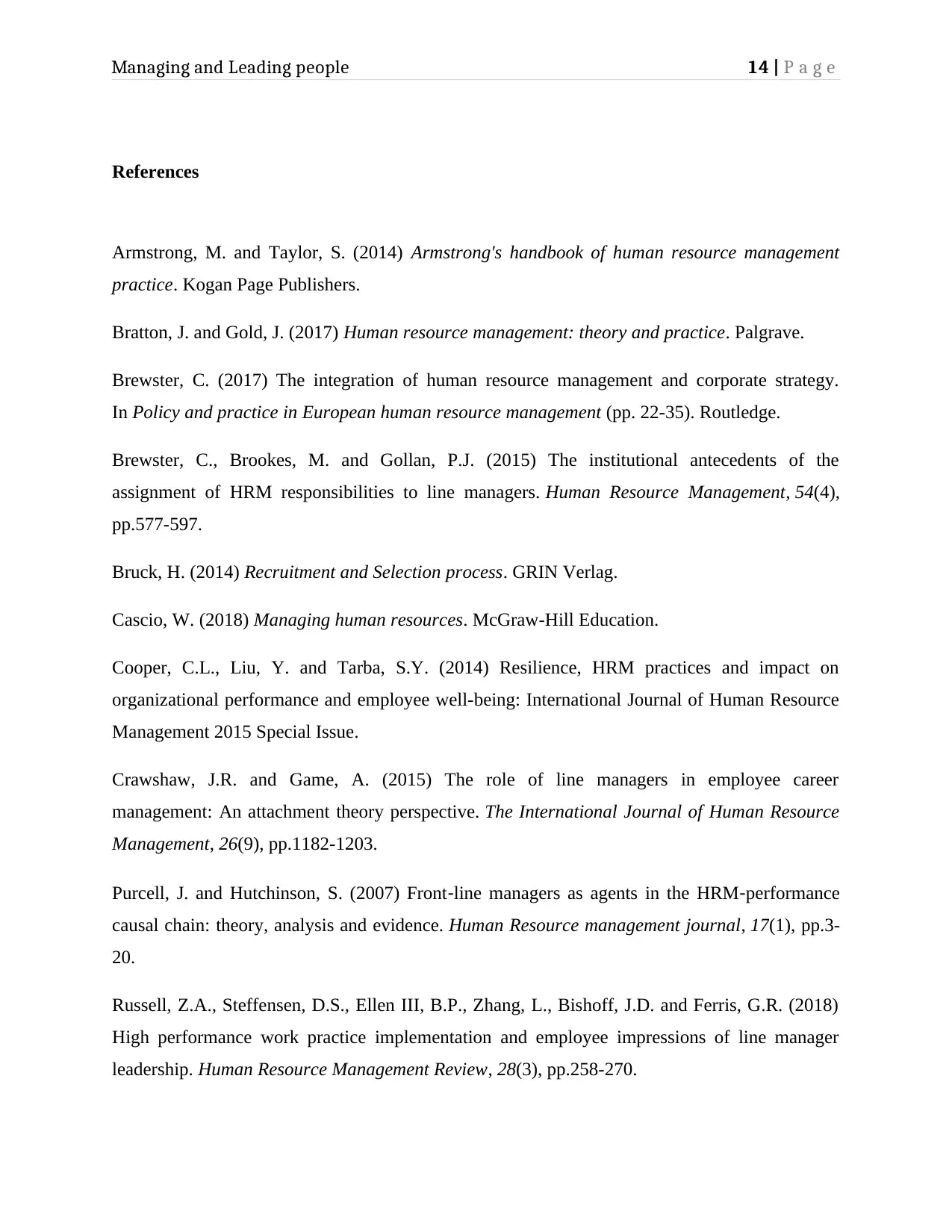
Managing and Leading people 14 | P a g e
References
Armstrong, M. and Taylor, S. (2014) Armstrong's handbook of human resource management
practice. Kogan Page Publishers.
Bratton, J. and Gold, J. (2017) Human resource management: theory and practice. Palgrave.
Brewster, C. (2017) The integration of human resource management and corporate strategy.
In Policy and practice in European human resource management (pp. 22-35). Routledge.
Brewster, C., Brookes, M. and Gollan, P.J. (2015) The institutional antecedents of the
assignment of HRM responsibilities to line managers. Human Resource Management, 54(4),
pp.577-597.
Bruck, H. (2014) Recruitment and Selection process. GRIN Verlag.
Cascio, W. (2018) Managing human resources. McGraw-Hill Education.
Cooper, C.L., Liu, Y. and Tarba, S.Y. (2014) Resilience, HRM practices and impact on
organizational performance and employee well-being: International Journal of Human Resource
Management 2015 Special Issue.
Crawshaw, J.R. and Game, A. (2015) The role of line managers in employee career
management: An attachment theory perspective. The International Journal of Human Resource
Management, 26(9), pp.1182-1203.
Purcell, J. and Hutchinson, S. (2007) Front‐line managers as agents in the HRM‐performance
causal chain: theory, analysis and evidence. Human Resource management journal, 17(1), pp.3-
20.
Russell, Z.A., Steffensen, D.S., Ellen III, B.P., Zhang, L., Bishoff, J.D. and Ferris, G.R. (2018)
High performance work practice implementation and employee impressions of line manager
leadership. Human Resource Management Review, 28(3), pp.258-270.
References
Armstrong, M. and Taylor, S. (2014) Armstrong's handbook of human resource management
practice. Kogan Page Publishers.
Bratton, J. and Gold, J. (2017) Human resource management: theory and practice. Palgrave.
Brewster, C. (2017) The integration of human resource management and corporate strategy.
In Policy and practice in European human resource management (pp. 22-35). Routledge.
Brewster, C., Brookes, M. and Gollan, P.J. (2015) The institutional antecedents of the
assignment of HRM responsibilities to line managers. Human Resource Management, 54(4),
pp.577-597.
Bruck, H. (2014) Recruitment and Selection process. GRIN Verlag.
Cascio, W. (2018) Managing human resources. McGraw-Hill Education.
Cooper, C.L., Liu, Y. and Tarba, S.Y. (2014) Resilience, HRM practices and impact on
organizational performance and employee well-being: International Journal of Human Resource
Management 2015 Special Issue.
Crawshaw, J.R. and Game, A. (2015) The role of line managers in employee career
management: An attachment theory perspective. The International Journal of Human Resource
Management, 26(9), pp.1182-1203.
Purcell, J. and Hutchinson, S. (2007) Front‐line managers as agents in the HRM‐performance
causal chain: theory, analysis and evidence. Human Resource management journal, 17(1), pp.3-
20.
Russell, Z.A., Steffensen, D.S., Ellen III, B.P., Zhang, L., Bishoff, J.D. and Ferris, G.R. (2018)
High performance work practice implementation and employee impressions of line manager
leadership. Human Resource Management Review, 28(3), pp.258-270.
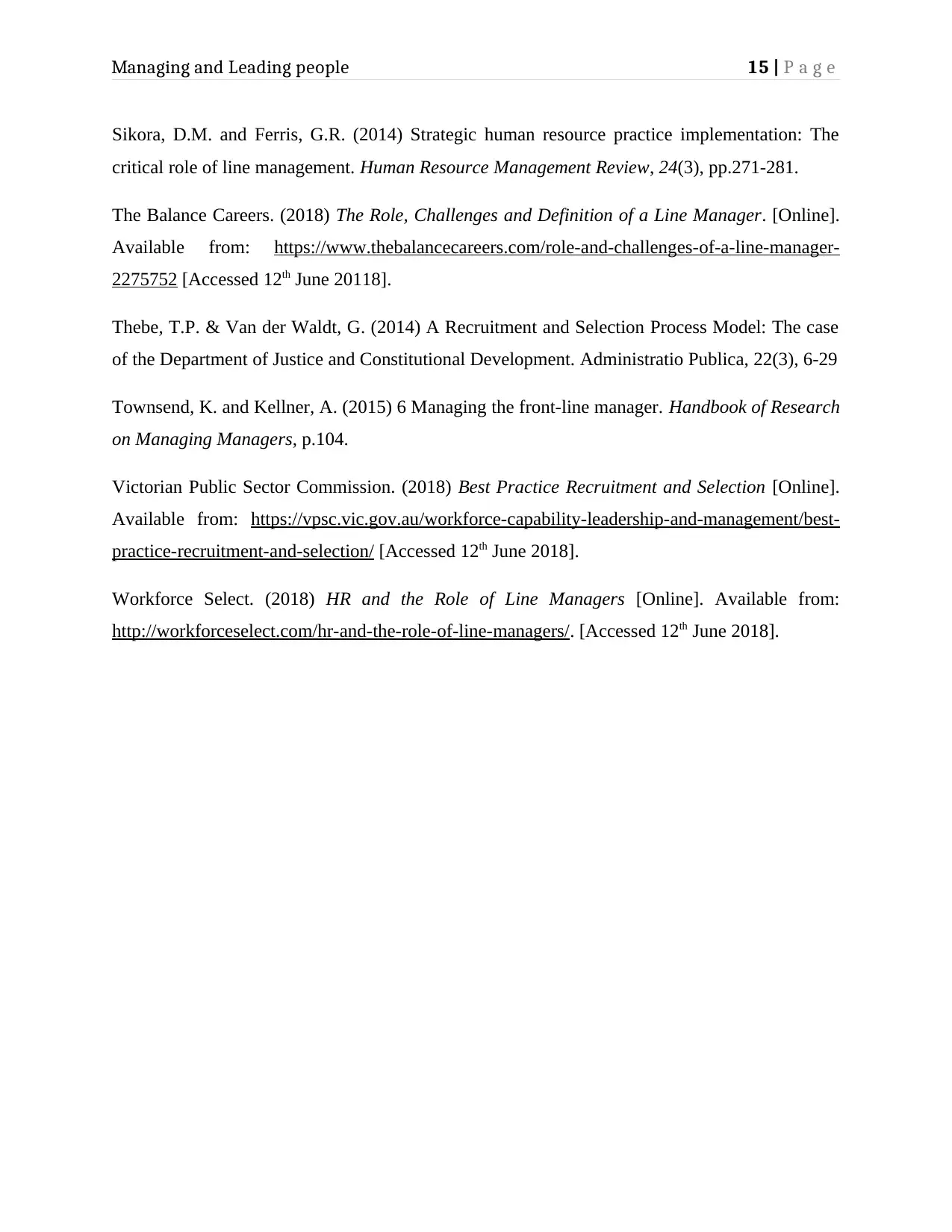
Managing and Leading people 15 | P a g e
Sikora, D.M. and Ferris, G.R. (2014) Strategic human resource practice implementation: The
critical role of line management. Human Resource Management Review, 24(3), pp.271-281.
The Balance Careers. (2018) The Role, Challenges and Definition of a Line Manager. [Online].
Available from: https://www.thebalancecareers.com/role-and-challenges-of-a-line-manager-
2275752 [Accessed 12th June 20118].
Thebe, T.P. & Van der Waldt, G. (2014) A Recruitment and Selection Process Model: The case
of the Department of Justice and Constitutional Development. Administratio Publica, 22(3), 6-29
Townsend, K. and Kellner, A. (2015) 6 Managing the front-line manager. Handbook of Research
on Managing Managers, p.104.
Victorian Public Sector Commission. (2018) Best Practice Recruitment and Selection [Online].
Available from: https://vpsc.vic.gov.au/workforce-capability-leadership-and-management/best-
practice-recruitment-and-selection/ [Accessed 12th June 2018].
Workforce Select. (2018) HR and the Role of Line Managers [Online]. Available from:
http://workforceselect.com/hr-and-the-role-of-line-managers/. [Accessed 12th June 2018].
Sikora, D.M. and Ferris, G.R. (2014) Strategic human resource practice implementation: The
critical role of line management. Human Resource Management Review, 24(3), pp.271-281.
The Balance Careers. (2018) The Role, Challenges and Definition of a Line Manager. [Online].
Available from: https://www.thebalancecareers.com/role-and-challenges-of-a-line-manager-
2275752 [Accessed 12th June 20118].
Thebe, T.P. & Van der Waldt, G. (2014) A Recruitment and Selection Process Model: The case
of the Department of Justice and Constitutional Development. Administratio Publica, 22(3), 6-29
Townsend, K. and Kellner, A. (2015) 6 Managing the front-line manager. Handbook of Research
on Managing Managers, p.104.
Victorian Public Sector Commission. (2018) Best Practice Recruitment and Selection [Online].
Available from: https://vpsc.vic.gov.au/workforce-capability-leadership-and-management/best-
practice-recruitment-and-selection/ [Accessed 12th June 2018].
Workforce Select. (2018) HR and the Role of Line Managers [Online]. Available from:
http://workforceselect.com/hr-and-the-role-of-line-managers/. [Accessed 12th June 2018].
1 out of 16
Related Documents
Your All-in-One AI-Powered Toolkit for Academic Success.
+13062052269
info@desklib.com
Available 24*7 on WhatsApp / Email
![[object Object]](/_next/static/media/star-bottom.7253800d.svg)
Unlock your academic potential
© 2024 | Zucol Services PVT LTD | All rights reserved.





